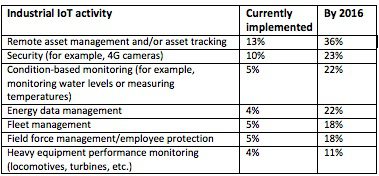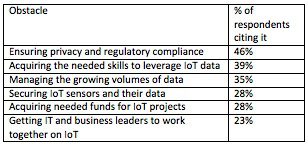Datamation content and product recommendations are
editorially independent. We may make money when you click on links
to our partners.
Learn More
When a new technology is prominently discussed on CBS TV’s 60 Minutes, you know it’s hit the peak of the Gartner hype cycle. So it goes with the Internet of Things (IoT). In early February an episode narrated by veteran correspondent Leslie Stahl highlighted some of the promises and pitfalls of IoT, with all of the requisite “gee whiz” and “Oh my gosh” type of comments expected from a TV show for the masses.
In the B2B world, new products, services, business models, better customer service, improved employee productivity and a host of other traditional IT-spending justifications are touted as the reward for successful IoT deployments. And while there have been some RoI from the IoT investments to date, the data are thin.
Indeed, the reality of IoT use today is a lot less sexy than the hype. A survey and report I was involved in with Harvard Business Review Analytic Services in September 2014 found relatively few organizations had IoT projects in production. Indeed, roughly half of the respondents weren’t familiar with the concepts, let alone worked in an organization looking at the technologies.
And of the few that had an IoT application in operation, most of the current implementations are just warmed over systems from 10 or 20 years ago. I wrote about smart locomotives, trucks, farm tractors and other devices decades ago. The majority of IoT systems in place today are just focused on monitoring and optimizing large and expensive physical assets like those already mentioned, along with turbines and jet engines. That’s why General Electric is spending over $1 billion on IoT (more on that later).
And the same focus on infusing new IoT technologies in existing business processes appears to be the watchword over the next year as well. While the percentages of organizations with IoT projects in place will double or triple by early 2016, the bulk of the projects will rely on the same proven business processes and models. Just keeping track of an organization’s equipment and people will remain the most popular applications, according to 269 respondents to the survey (see table below). Note that a large majority of the respondents were managers, and that roughly half were in companies with more than 1,500 employees. They represented a wide variety of roles, business sectors and regions.

Source: “Internet of Things: Science Fiction or Business Fact?” By Harvard Business Review Analytic Services, 2014 (combination of published and unpublished data)
Of course, closing the gap between the promise and the reality of IoT relies on information technology and the IT departments. Roughly half of respondents said that IoT has increased the complexity of the IT department’s operations. And half also noted that securing the devices and the data flows, and the resulting privacy concerns, are big impediments to IoT deployments (see table).

Source: “Internet of Things: Science Fiction or Business Fact?” By Harvard Business Review Analytic Services, 2014 (combination of published and unpublished data)
IT spending to support IoT is rising rapidly and those budgets will help close the gap. General Electric has committed several billion dollars to its IoT efforts. An article in the November 2014 issue of Harvard Business Review, part of a package on IoT, said that GE was planning to hire 1,000 IoT/software engineers in San Ramon, CA facility (across the Bay from Silicon Valley) by the end of 2014.
Developing the security and privacy provisions to protect IoT data, deployment of a lot of sensors, and a network to collect their signals may be the easiest aspects required to support the new opportunities. As the table shows, there are some major hardware and systems challenges ahead for IT departments.
And make no mistake – IT is viewed by most survey respondents as a key player in IoT. Capturing and processing all of the data will be a Herculean task and a huge business opportunity. That’s why Cisco, IBM and a host of other hardware and software companies are so focused on IoT.
One key area that has not received enough IoT-related attention is real-time processing. Just like other factors driving increased demand for real-time processing – such as the rise of mobile devices supporting sales people, and the growing ranks of Millennials expecting Google- or Amazon-type instant gratification – IoT is yet another nail in the coffin of batch shops. The whole point of IoT is to be able to quickly respond to opportunities and challenges, and that flood of IoT data needs to be parsed rapidly.
However, as IT professionals consider their options about where and how to dive into the IoT pool, keep two somewhat contradictory research findings in mind:
1. New technologies seldom achieve as much adoption as forecast in the short term.
2. New technologies frequently exceed forecast adoption in the long term.
Photo courtesy of Shutterstock.
-
Ethics and Artificial Intelligence: Driving Greater Equality
FEATURE | By James Maguire,
December 16, 2020
-
AI vs. Machine Learning vs. Deep Learning
FEATURE | By Cynthia Harvey,
December 11, 2020
-
Huawei’s AI Update: Things Are Moving Faster Than We Think
FEATURE | By Rob Enderle,
December 04, 2020
-
Keeping Machine Learning Algorithms Honest in the ‘Ethics-First’ Era
ARTIFICIAL INTELLIGENCE | By Guest Author,
November 18, 2020
-
Key Trends in Chatbots and RPA
FEATURE | By Guest Author,
November 10, 2020
-
Top 10 AIOps Companies
FEATURE | By Samuel Greengard,
November 05, 2020
-
What is Text Analysis?
ARTIFICIAL INTELLIGENCE | By Guest Author,
November 02, 2020
-
How Intel’s Work With Autonomous Cars Could Redefine General Purpose AI
ARTIFICIAL INTELLIGENCE | By Rob Enderle,
October 29, 2020
-
Dell Technologies World: Weaving Together Human And Machine Interaction For AI And Robotics
ARTIFICIAL INTELLIGENCE | By Rob Enderle,
October 23, 2020
-
The Super Moderator, or How IBM Project Debater Could Save Social Media
FEATURE | By Rob Enderle,
October 16, 2020
-
Top 10 Chatbot Platforms
FEATURE | By Cynthia Harvey,
October 07, 2020
-
Finding a Career Path in AI
ARTIFICIAL INTELLIGENCE | By Guest Author,
October 05, 2020
-
CIOs Discuss the Promise of AI and Data Science
FEATURE | By Guest Author,
September 25, 2020
-
Microsoft Is Building An AI Product That Could Predict The Future
FEATURE | By Rob Enderle,
September 25, 2020
-
Top 10 Machine Learning Companies 2021
FEATURE | By Cynthia Harvey,
September 22, 2020
-
NVIDIA and ARM: Massively Changing The AI Landscape
ARTIFICIAL INTELLIGENCE | By Rob Enderle,
September 18, 2020
-
Continuous Intelligence: Expert Discussion [Video and Podcast]
ARTIFICIAL INTELLIGENCE | By James Maguire,
September 14, 2020
-
Artificial Intelligence: Governance and Ethics [Video]
ARTIFICIAL INTELLIGENCE | By James Maguire,
September 13, 2020
-
IBM Watson At The US Open: Showcasing The Power Of A Mature Enterprise-Class AI
FEATURE | By Rob Enderle,
September 11, 2020
-
Artificial Intelligence: Perception vs. Reality
FEATURE | By James Maguire,
September 09, 2020
SEE ALL
DATA CENTER ARTICLES









